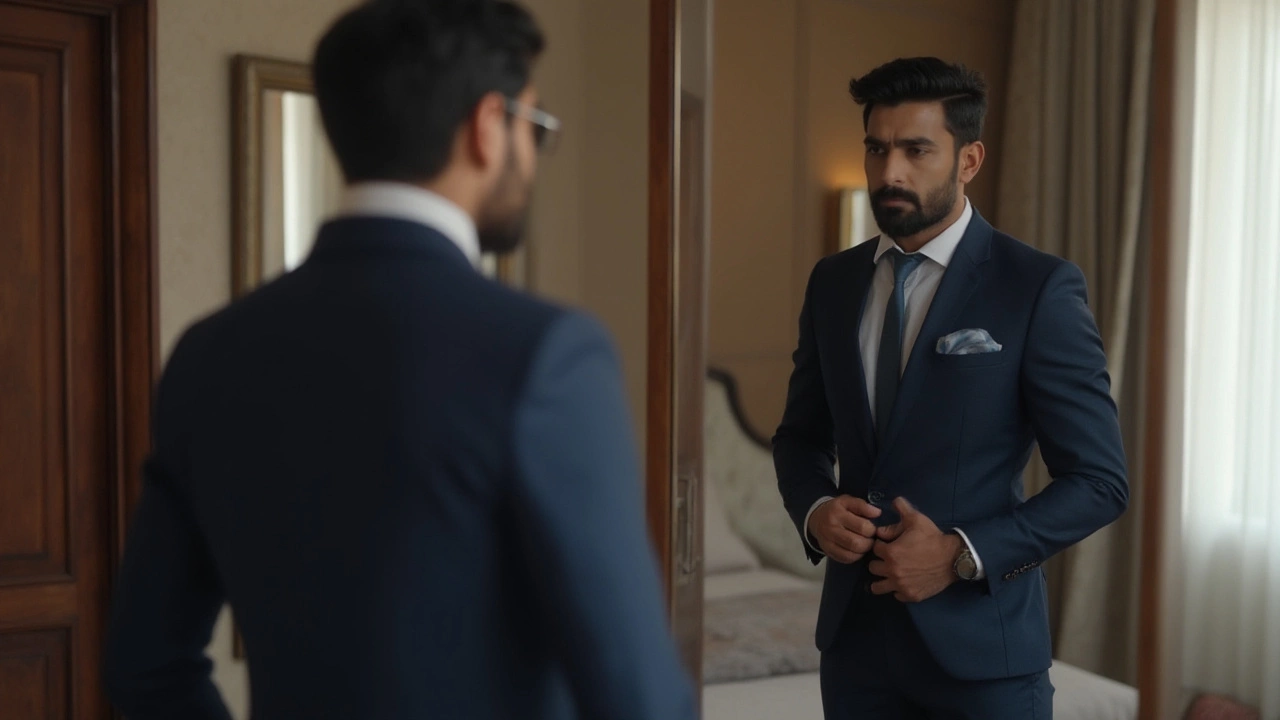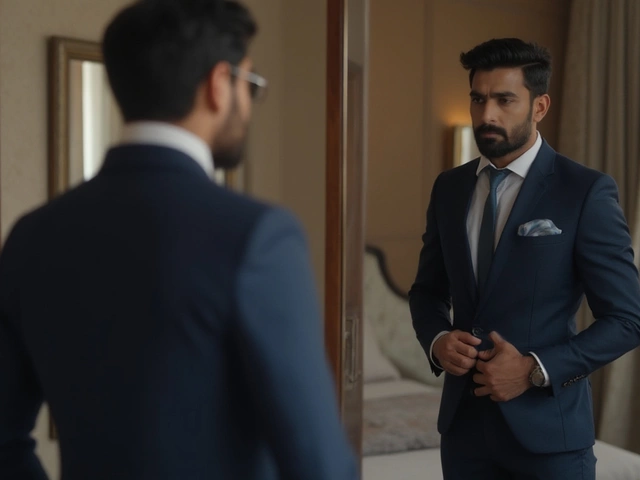
Staring at yourself in the shop mirror, all suited up, and feeling more inflated than impressive? You're definitely not the only one. There’s a reason some guys dread formalwear: the wrong suit can add kilos you never asked for. But here’s the thing: the suit itself isn’t the culprit—it’s how you pick, wear, and tweak it that makes or breaks your look. Fancy losing that 'puffy' vibe and stepping into sharper, confidence-boosting territory? This is for you.
Understanding Why Some Suits Make You Look Bigger
Ever wonder why some suits feel like a confidence costume, and others just scream "awkward family wedding"? It's not magic—it's science and a splash of illusion. The cut, color, fabric, and even the details can either sculpt you slimmer or layer you wider. Let’s break down the reasons:
- Fit is king—and most men get fit wrong. Baggy suits hide nothing; they swallow you up. Conversely, ultra-tight tailoring creates bulges and odd creases that draw attention to every bump. The ideal suit shape skims, not squeezes, your frame.
- Shoulder pads and jacket structure can add bulk. Too much padding or a boxy cut at the top can broaden you unnecessarily—especially if you naturally have wide shoulders or a bigger chest.
- Fabric choice matters more than you’d think. Thick, heavily textured weaves like tweed or boucle add visual weight, while lightweight wool, linen blends, and high-twist fabrics lie flatter on your body.
- Poor trouser shape causes havoc below the belt. Tapered legs that narrow at the ankle elongate the silhouette, while wide or flared fits can shorten you and make your legs look blocky.
- Details—like pocket placement or lapel width—might look tiny, but stacked or horizontal pockets, thick lapels, or noisy patterns can split up your shape and add visual width.
You know what’s wild? A study from the University of Hertfordshire found that how we perceive our own body image is drastically affected by what we wear and even the angle at which we stand in front of a mirror. Standing straight and picking a jacket that follows the natural line of your body can instantly trick your mind (not to mention the camera) into seeing a leaner outline.
Mastering the Art of Tailoring (Without Spending a Fortune)
Nothing shrinks your silhouette like a well-fitted jacket—fact. Forget grabbing a suit off the rack, shrugging into it, and calling it good. Even a pricier designer suit looks off when the fit isn’t dialed in. It’s tailoring that pulls everything together, even if your body isn't what magazines call "model-esque." Let’s zero in on what a killer fit looks like and how to get it without selling your soul (or your PS5) for a Savile Row bill.
- Shoulders first: The seam needs to end right where your natural shoulder drops off—no overhang, no tight bunching. This is almost impossible to alter, so always buy for your shoulders first.
- Slim through the sides: A good tailor can nip in the waist of a jacket for a v-shaped look. You’re not going for body-hugging, but you do want to avoid a boxy fit. A gentle taper creates the illusion of broad shoulders and a smaller midsection.
- Jacket length: Mid-crotch, not beyond. Longer jackets dwarf the legs and add bulk. The golden rule? The hem should cup the curve of your butt, not swallow it.
- Sleeves that don’t swamp: They should hit at your wrist bone, letting a half-inch of shirt cuff peek out. Baggy or long sleeves look sloppy and oversized.
- Perfect pants: No skinny jeans, no puddling. You want trousers to graze the tops of your shoes with a neat break. Gentle tapers down the leg look smart and cut weight from your lower half.
Trouser rise matters too. Lower rise can push your waistband under your gut and create a muffin-top look—no, thank you. Mid-rise sits at your real waist, which elongates your frame and avoids spills. Tailors in Brighton will often fix up off-the-rack suits for less than £60, and it’s probably the smartest money you’ll spend this wedding season.
Tom Ford—who knows more than a thing or two about sharp male silhouettes—said,
“Dressing well is a form of good manners.”A crisp suit, hugging in the right places, tells people you care how you present yourself. Even better: it makes you feel in control, which does wonders for your posture and your self-esteem.

Choosing the Perfect Colours and Patterns
If black really was the magical slimming color, we’d all be cloaked in it daily. Truth is, color theory goes a lot deeper, and some hues and patterns work way harder than others to flatter you. Here’s how to play the palette for instant streamlining:
- Navy and deep charcoal are real MVPs. They hide shadows and lumps more than any light color can. Pure black works but can look severe and age you if your skin tone’s on the lighter side.
- Keep things simple. Block colors with minimal break between jacket and trousers create an unbroken vertical line, which makes you look taller and leaner. If you mix-and-match with a lighter bottom, your eyes get drawn sideways—the last thing you want.
- Pinstripes aren’t just for 1930s bankers. A subtle, narrow vertical stripe draws the eye up and down, elongating your body. Skip chunky or widely spaced stripes; these do the opposite and add girth.
- Bold checks or windowpane patterns can add width if you’re already broad, so go for textured solids or micro-patterns if you want to look trimmer.
- Shirt color matters. Stick with a light, plain shirt under a dark suit. It gives a clean, streamlined effect. Overly patterned or dark shirts against dark jackets can blur your outline and create a blocky look.
Don't overlook accessories, either. A tie that’s too wide can visually widen your torso, so opt for a standard width that matches your lapel. Belts should be slim (not chunky) and not draw the eye to the waist. Even socks matter—skip wild patterns and use darker shades to keep the line unbroken down to your shoes.
The House of Colour, a UK style consultancy, did a survey last year showing that men who wore coordinated, deeper shades felt more attractive and confident, simply because those colors balanced their proportions and hid areas they didn’t feel comfortable with.
Smart Layering and Subtle Hacks for a Leaner Look
If you’re already sweating at thought of extra layers, don’t worry—it’s not about bulking up. Smart layering is all about using underlayers to smooth out your lines, fix up posture, and even help with under-arm stains (because nothing screams 'tough day' like sweat patches under ceremony lights).
- An undershirt (tight, stretchy, seamless) helps even out the upper body, prevents nipple show-through, and gently holds the stomach. The Spanx for Men "Zoned Performance" tee is a lifesaver for those who want a little more control under a dress shirt.
- Waistcoats can be a double-edged sword. Too tight and they push fat up and over. Just right and they bisect the midsection, breaking up your belly and creating vertical lines. Pick single-breasted styles in darker colors and wear them open if you’re worried about strain buttons.
- Unstructured blazers are increasingly popular and with reason: no heavy lining, no blocky padding, just a softer drape. These types give you structure without the square edges that add size.
- Shoulder posture hack: Pop your phone in your inside jacket pocket—just heavy enough to pull your shoulder blades back. Instant posture fix, at least for your wedding photos.
And here’s something most guys skip: professional photos almost always have subjects standing with their weight slightly on their back foot, front hand in jacket pocket, and shoulders back. It’s not by accident. Even the slimmest men need strategic posing to look their best in a suit.
Above everything, confidence pulls the whole thing together. You might have the sharpest, most streamlined navy suit in the room, but walking in hunched or constantly tugging at your lapels will out the nerves faster than any loose button ever could. Suit up, stand tall, and remember: everyone else is worrying about their own dad-bod.


Comments
Post Comment